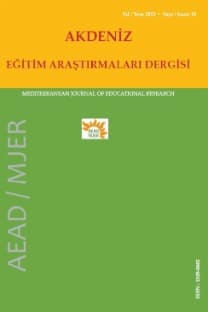STEM: Öğretmenlerin Metaforik Algıları
STEM: Metaphorical Perceptions of Teachers
___
- Akınoğlu, O. (2005). Türkiye’de uygulanan ve değişen eğitim programlarının psikolojik temelleri. O. M.Ü. Atatürk Eğitim Fakültesi Eğitim Bilimleri Dergisi, 2005(22), 31-46.
- Bozanoğlu, B. (2017). STEM uygulamalarına yönelik algıların metaforlar aracılığıyla analizi. Fatih Projesi Eğitim Teknolojileri Zirvesi 17-18 Kasım 2017.
- Brooks, J. G., & Brooks, M. J. (1993). In search of understanding: the case for constructivist classrooms. New York, USA: Alexandria VA: Association for Supervision and Curriculum Development.
- Bybee, R. W. (2013). The case for STEM education: Challenges and opportunities. NSTA press.
- Creswell, J. W. (2016). Nitel araştırma yöntemleri: Beş yaklaşıma göre nitel araştırma ve araştırma deseni. (Çev. Ed.: M. Bütün & S. B. Demir). Ankara: Siyasal Kitabevi.
- Çepni, S. (2017). Kuramdan Uygulamaya STEM Eğitimi. Ankara: Pegem Akademi.
- Dugger, W. E. (2010). Evolution of STEM in the United States. In 6th Biennial International Conference on Technology Education Research in Australia.
- Eroğlu, S., & Bektaş, O. (2016). STEM eğitimi almış fen bilimleri öğretmenlerinin STEM temelli ders etkinlikleri hakkındaki görüşleri. Eğitimde Nitel Araştırmalar Dergisi - Journal of Qualitative Research in Education, 4(3), 43-67.
- Gay, G., & Howard, T. C. (2000). Multicultural teacher education for the 21st century. The Teacher Educator, 36(1), 1-16.
- Gonzalez, H. B., Kuenzi, J. J. (2012). Science, technology, engineering, and mathematics (STEM) education: A primer. Congressional Research Service, Library of Congress.
- Kenney, M. (2013). Journeys, Adventures, Bridges and Puzzles: A case study approach to understanding teachers' conceptions of STEM. Arizona State University.
- Merriam, S. B. (2016). Nitel araştırma. Desen ve Uygulama İçin Bir Rehber. (Çev. Ed.: S. Turan). Ankara: Nobel Akademik Yayıncılık.
- Milli Eğitim Bakanlığı Talim ve Terbiye Kurulu Başkanlığı (2017). İlköğretim Kurumları (ilkokullar ve ortaokullar) Fen Bilimleri Dersi Öğretim Programı. Ankara: MEB Yayınevi.
- Milli Eğitim Bakanlığı Talim ve Terbiye Kurulu Başkanlığı (2018). İlköğretim Kurumları Fen Bilimleri Dersi Öğretim Programı. Ankara: MEB Yayınevi.
- Miles, M. B. & Huberman, A. M. (1994). Qualitative data analysis: An expanded sourcebook. Sage Publications.
- Morgan, G. (2006). Images of organization (updated edition). Sage Publications.
- Morrison, J. (2006). Attributes of STEM education: The student, the school, the classroom. TIES (Teaching Institute for Excellence in STEM), 20.
- Niaz, M. (2016). Understanding stoichiometry: Do scientific laws help in learning science?. M. Niaz (Ed.), In Chemistry Education and Contributions from History and Philosophy of Science (pp. 125-141). Springer International Publishing.
- Özdemir, M. (2010). Nitel veri analizi: Sosyal bilimlerde yöntembilim sorunsalı üzerine bir çalışma. Eskişehir Osmangazi Üniversitesi Sosyal Bilimler Dergisi, 11(1), 323-343.
- Özden, Y. (2005). Eğitimde yeni değerler. Ankara: Pegem Yayıncılık.
- Özmen, H. (2004). Fen öğretiminde öğrenme teorileri ve teknoloji destekli yapılandırmacı (constructivist) öğrenme. The Turkish Online Journal of Educational Technology, 3(1), 100-111.
- Partnership for 21st Century Learning (2015). Framework for 21st Century Learning.
- Perkins, D. N. (1999). The many faces of constructivism. Educational Leadership, 57(3), 6-11.
- Sanders, M. E. (2008). STEM, STEM education, STEMmania. The Technology Teacher.
- Scott, M. C. (2009). Technology Education for Children Council. It’s Elementary, Too!, 2.
- Smith, J., & Karr-Kidwell, P. J. (2000). The Interdisciplinary Curriculum: A Literary Review and a Manual for Administrators and Teachers.
- Thomas, T. A., (2014). Elementary teachers’ receptivity to ıntegrated science, technology, engineering, and mathematics (STEM) education in the elementary grades. (Doctoral dissertation). Retrieved from Proquest.
- Trowbrıdge, L., Bybee, R.W., & Powell, J.C. (2004). Teaching secondary school science. New Jersey: Merrill / Prentice Hall.
- Wang, H. H., Moore, T. J., Roehrig, G. H., & Park, M. S. (2011). STEM integration: Teacher perceptions and practice. Journal of Pre-College Engineering Education Research, 1(2), 2.
- Yıldırım, B., & Altun, Y. (2015). STEM eğitimi üzerine derleme çalışması: Fen bilimleri alanında örnek ders uygulanmaları. International Congress of Education Research’da sunulmuş bildiri, Hacettepe Üniversitesi, Ankara.
- Yıldırım, A., & Şimşek, H. (2016). Sosyal bilimlerde nitel araştırma yöntemleri. Ankara: Seçkin Yayıncılık.
- Yıldırım, B., Türk, C. (2018). Opinions of Secondary School Science and Mathematics Teachers on STEM Education. World Journal on Educational Technology: Current Issues, 10(1), 52-60
- ISSN: 1309-0682
- Yayın Aralığı: Yılda 4 Sayı
- Başlangıç: 2008
- Yayıncı: Tayfun Taşbilek
Halil İbrahim AKILLI, CEMİL AYDOĞDU
KKTC ve TC'li Ailelerin Ödev ile İlgili Görüşlerinin Karşılaştırılması
Öğretim İlke ve Yöntemleri Dersi İçin Bir Başarı Testi Geliştirme Süreci
ÇİĞDEM SUZAN ÇARDAK, Kıymet SELVİ
Sosyal Bilgiler Ders Kitaplarında Türk İslam Bilginleri
KKTC ve TC'li Ailelerin Ödev ile İlgili Görüşlerinin Karşılaştırılması
Türk Öğretmen Adaylarının Olası Benliklerinin İncelenmesi
Muzaffer Pınar BABANOĞLU, Reyhan AĞÇAM
Lisans Derslerinin Yürütülmesinde Sosyal Ağların Kullanımı ile İlgili Öğrenci Görüşleri
Ahmet Onur ÇOBANOĞLU*, SALİH ZEKİ GENÇ
Türkiye'de Biyoloji Öğretiminde Yaşanılan Sorunlar ve Çözüm Önerileri: Akademisyen Perspektifi
STEM: Öğretmenlerin Metaforik Algıları
Kadri̇ye Begüm DOĞRUYOL ALADAK, SERACEDDİN LEVENT ZORLUOĞLU, Melek DÖNMEZ YAPUCUOĞLU
